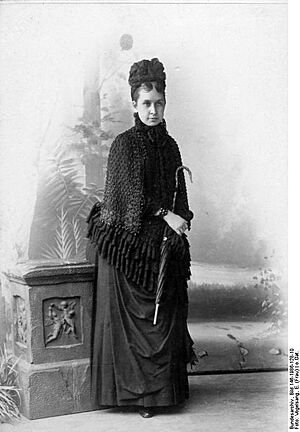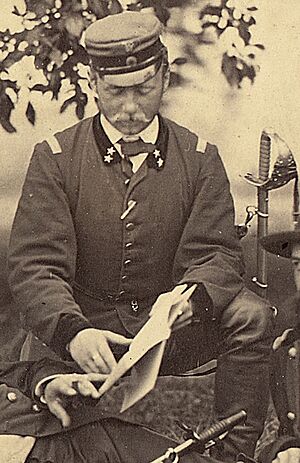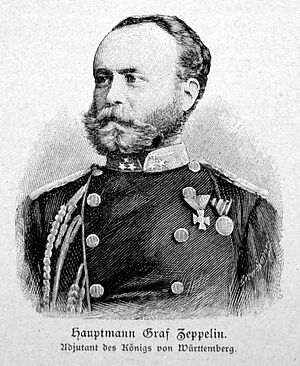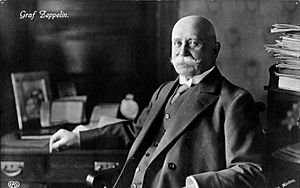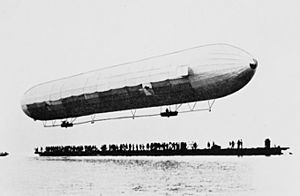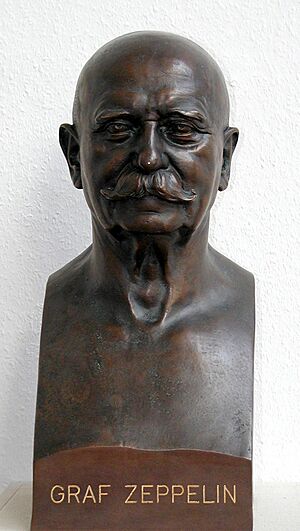Ferdinand von Zeppelin facts for kids
Quick facts for kids
Graf
Ferdinand von Zeppelin
|
|
|---|---|
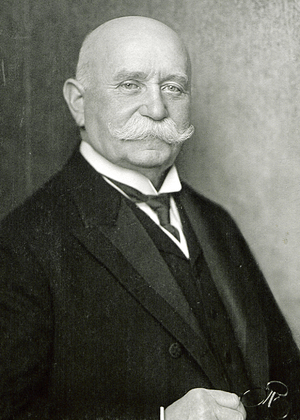
Count Ferdinand von Zeppelin (1917)
|
|
| Native name |
Graf Ferdinand Adolf Heinrich August von Zeppelin
|
| Born | 8 July 1838 Konstanz, Grand Duchy of Baden (now part of Baden-Württemberg, Germany) |
| Died | 8 March 1917 (aged 78) Berlin, German Empire |
| Allegiance | Grand Duchy of Baden (1855–1917) German Empire (1871–1917) |
| Service/ |
Infantry |
| Years of service | 1855-1885, 1890 |
| Rank | Generalleutnant |
| Commands held | 19th Uhlans |
| Spouse(s) | Isabella Freiin von Wolff (m. 1869–1917; his death) |
| Signature | |
Count Ferdinand von Zeppelin was a German general who later became famous for inventing the Zeppelin airships. He also started the company that built them, called Luftschiffbau Zeppelin. He was born on July 8, 1838, and passed away on March 8, 1917.
Contents
Early Life and Family
Ferdinand came from a noble family. Their family name, Zeppelin, came from a small town called Zepelin in Germany.
His father was Friedrich Jerôme Wilhelm Karl Graf von Zeppelin, a minister in the Kingdom of Württemberg. His mother was Amélie Françoise Pauline. Ferdinand grew up with his sister and brother at their Girsberg manor near Konstanz. He was taught by private tutors at home.
On August 7, 1869, Ferdinand married Isabella Freiin von Wolff in Berlin. They had one daughter, Helene (Hella) von Zeppelin, who was born in 1879.
Military Career
Ferdinand von Zeppelin began his military career in 1855. He joined the military school at Ludwigsburg and became an army officer in the Württemberg army.
By 1858, he was promoted to lieutenant. He took time off to study science, engineering, and chemistry at Tübingen University. His studies were interrupted in 1859 when he was called to serve in the Austro-Sardinian War.
In 1863, Zeppelin traveled to the United States. He observed the Union Army during the American Civil War in Virginia. Later, he went to Minnesota. There, he met a balloonist named John Steiner. On August 19, he made his first flight in a balloon with Steiner. Many years later, he said this experience inspired his ideas about airships.
In 1865, Zeppelin became an assistant to the King of Württemberg. He also served as a general staff officer in the Austro-Prussian War of 1866. For his service, he received the Ritterkreuz (Knight's Cross). During the Franco-Prussian War (1870–1871), he became famous for a brave scouting mission behind enemy lines.
From 1882 to 1885, Zeppelin commanded the 19th Uhlans, a cavalry unit. He then became an envoy for Württemberg in Berlin. In 1890, he returned to army service, leading a Prussian cavalry brigade. However, his performance was criticized, and he was forced to retire from the Army. He retired with the rank of Generalleutnant, a high-ranking general.
Developing Airships
Zeppelin's interest in airships began after his balloon flight in Minnesota. He wrote down his ideas for large airships in his diary in 1874. He imagined a large, rigid outer frame with many separate gasbags inside.
After leaving the army in 1891, at age 52, Zeppelin focused completely on airships. He hired engineers to test materials and engines. He also worked to get purer hydrogen gas for his designs.
His main idea was an airship with a strong aluminum frame covered in fabric. Inside, there would be many separate gas cells. This design allowed the airship to be built in sections. Controls, engines, and the passenger area (gondola) were firmly attached.
In 1893, his detailed designs were reviewed by the Prussian Army. They did not approve his design at first. However, in August 1895, Zeppelin received a patent for his design. He called it an "airship-train."
In 1896, Zeppelin gave a lecture about his airship designs. It impressed the Association of German Engineers (VDI) so much that they asked the public to help fund his work. This led to him working with Carl Berg, who supplied aluminum. In 1898, they formed a company called Gesellschaft zur Förderung der Luftschiffart. Zeppelin invested a large amount of his own money. This allowed the construction of the first successful rigid airship, the Zeppelin LZ1.
First Flights and Challenges
On July 2, 1900, Zeppelin made the first flight with the LZ 1 over Lake Constance in Germany. The airship flew for 20 minutes but was damaged when it landed. After repairs, it made two more flights in October 1900. However, the government did not think it was successful enough to invest in. Since Count Zeppelin had used all his money, he had to stop his work for a while.
Zeppelin still had the support of the King of Württemberg. The king approved a state lottery that raised 124,000 marks. Prussia also contributed 50,000 marks. Zeppelin raised the rest of the money by using his wife's properties as collateral.
In April 1905, construction began on his second airship, the LZ 2. It was finished by November 30. During its first move out of the hangar, it was damaged. Repairs were completed by January 17, 1906, when LZ 2 made its only flight. It rose too high and faced strong winds. Both engines failed, leaving the airship unable to steer. It landed near Kisslegg but was severely damaged by high winds overnight and had to be taken apart.
Success and Public Support
In May 1906, work started on a third airship, LZ 3. This airship was similar to LZ 2 but could hold more gas. It made two successful flights, reaching speeds of 30 mph (48 km/h). In 1907, it reached 36 mph (58 km/h).
The success of LZ 3 changed how officials viewed his work. The German parliament (Reichstag) voted to give him 500,000 marks to continue. However, the government would only buy an airship if it could complete a 24-hour test flight. Knowing LZ 3 couldn't do this, Zeppelin started building a larger airship, the LZ 4.
LZ 4 first flew on June 20, 1908. A major breakthrough happened after LZ 4 was destroyed by fire at Echterdingen. This happened when it broke free from its moorings during a storm. The airship's earlier flights had already made the public very excited. After the fire, a public fundraising campaign collected over 6 million German marks! This money was used to create the 'Luftschiffbau-Zeppelin GmbH' company and the Zeppelin foundation.
After LZ 4 was destroyed, LZ 3 was repaired and made longer. On October 27, 1908, it made a flight lasting almost six hours with Prince Heinrich, the Kaiser's brother, on board. On November 7, with Crown Prince William as a passenger, it flew 80 km (50 mi) to Donaueschingen. Despite bad weather, the flight was a success. Two days later, LZ 3 was officially accepted by the government. On November 10, the Kaiser visited Friedrichshafen and awarded Zeppelin the Order of the Black Eagle.
Even though a new airship, the LZ 5, was built and accepted by the Army, Zeppelin's relationship with military leaders was still difficult. However, Alfred Colsman, the business director of Luftschiffbau-Zeppelin, came up with a great idea. He decided to use the public's excitement to start a passenger-carrying business.
Before 1914, the German Aviation Association (DELAG) carried 37,250 people on over 1,600 flights without any accidents. This marked the beginning of the age of air transportation.
Other Aircraft Projects
Ferdinand von Zeppelin also supported other aviation projects:
- In 1912, he financially supported Flugzeugbau Friedrichshafen, a company that built airplanes.
- In 1914, he asked Claude Dornier to develop flying boats.
- In 1914, he founded Versuchsbau Gotha-Ost with Robert Bosch. This company built large aircraft known as Riesenflugzeug (giant aircraft), like the Zeppelin-Staaken R.VI.
Legacy
Count Zeppelin passed away in 1917, before World War I ended. So, he did not see the temporary halt of the Zeppelin project due to the Treaty of Versailles. He also didn't see the later comeback of Zeppelins under his successor, Hugo Eckener.
Many things were named after him:
- The unfinished World War II German aircraft carrier Graf Zeppelin.
- Two famous rigid airships: the world-traveling LZ 127 Graf Zeppelin and LZ 130 Graf Zeppelin II, which was similar to the Hindenburg.
The British rock group Led Zeppelin also got their name from his airships. His granddaughter, Countess Eva von Zeppelin, once threatened to sue them for using the family name!
In 1975, Zeppelin was honored by being inducted into the International Air & Space Hall of Fame.
See also
 In Spanish: Ferdinand von Zeppelin para niños
In Spanish: Ferdinand von Zeppelin para niños


